Kia Motors Bundle
How is Kia Redefining the Automotive Market?
Kia Motors has dramatically transformed its approach, evolving from a value-focused brand to a leader in style and innovation. This shift is evident in its 'Movement that Inspires' campaign and a complete rebranding, including a new logo in 2021, marking a pivotal moment in its history. Founded 77 years ago, Kia's journey is a compelling case study in strategic adaptation and market dominance.
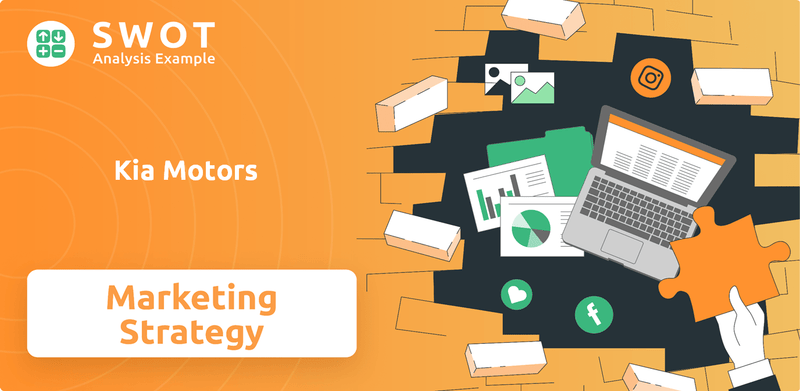
This deep dive into Kia Motors SWOT Analysis will uncover the sophisticated sales and marketing strategies driving its success. We'll examine its Kia Motors sales strategy, explore its innovative Kia Motors marketing strategy, and analyze its strategic positioning within the competitive automotive landscape. Discover how Kia leverages Kia Motors strategy to achieve impressive Kia Motors market share growth and build its Kia Motors brand positioning while gaining a Kia Motors competitive advantage in the global market.
How Does Kia Motors Reach Its Customers?
The sales strategy of Kia Motors centers on a multi-channel approach, blending both online and offline methods to reach a wide audience. This strategy is crucial for maintaining and expanding its market presence, especially in a competitive automotive landscape. The company's sales channels are designed to cater to various customer preferences and buying behaviors, ensuring accessibility and convenience.
A significant part of Kia's sales strategy involves its extensive network of physical dealerships. In the U.S. alone, Kia operates through nearly 800 dealerships, utilizing a franchise model. These dealerships handle sales of new and used vehicles, serving both retail and fleet customers. This widespread physical presence is a cornerstone of Kia's sales operations, providing direct customer interaction and support.
Kia is also actively evolving its sales channels to embrace digital solutions and omnichannel integration. This includes the planned expansion of its digital retailing strategy, 'EasyBuy,' in 2025. This tool aims to streamline the buying process, creating a seamless experience between the company's website, kia.com, and its dealerships. This digital focus reflects Kia's commitment to adapting to changing consumer preferences and enhancing the overall customer journey.
Kia's primary sales channel includes a vast network of physical retail locations. The company operates through a franchise model with nearly 800 dealers in the U.S. These dealerships are crucial for handling sales of new and used cars across retail and fleet segments.
Kia plans to roll out its digital retailing strategy more widely in 2025. The 'EasyBuy' tool aims to create a seamless customer experience between the website and dealerships. This approach is designed to modernize the buying process.
Kia is expanding its sales channels for its Platform Beyond Vehicle (PBV) business. The company plans to enhance both online and offline sales for B2B customers. A dedicated PBV website and a body-builder conversion portal will be launched.
Kia aims to establish 640 PBV dealerships in Europe by 2025. The company is recruiting external dealers to expand coverage and expertise. This expansion is part of Kia's strategy to provide tailored mobility solutions.
Furthermore, Kia is broadening its sales channels for its Platform Beyond Vehicle (PBV) business, targeting B2B customers. This involves enhancing both online and offline sales strategies. Kia plans to designate select dealerships as PBV specialists and develop business lounges for customers. On the online front, a dedicated PBV website and a body-builder conversion portal will be launched. The company aims to establish 640 PBV dealerships in Europe by 2025, recruiting external dealers to expand coverage and expertise. This strategic move underscores Kia's commitment to providing tailored mobility solutions and establishing a strong presence in the light commercial vehicle (LCV) market. For more insights, you can explore a detailed analysis of the [Kia Motors sales strategy](https://www.example.com/kia-motors-sales-strategy) to understand how these channels contribute to the company's overall success.
Kia's sales strategy focuses on a multi-channel approach to reach a broad customer base. The company uses a mix of physical dealerships, digital retailing, and specialized channels for its PBV business.
- Extensive Dealership Network: Nearly 800 dealerships in the U.S. provide a physical presence.
- Digital Integration: 'EasyBuy' tool to streamline online and in-store buying experiences.
- PBV Expansion: Dedicated online resources and specialized dealerships for B2B customers.
- European PBV Focus: Aiming for 640 PBV dealerships by 2025 to enhance B2B sales.
Kia Motors SWOT Analysis
- Complete SWOT Breakdown
- Fully Customizable
- Editable in Excel & Word
- Professional Formatting
- Investor-Ready Format
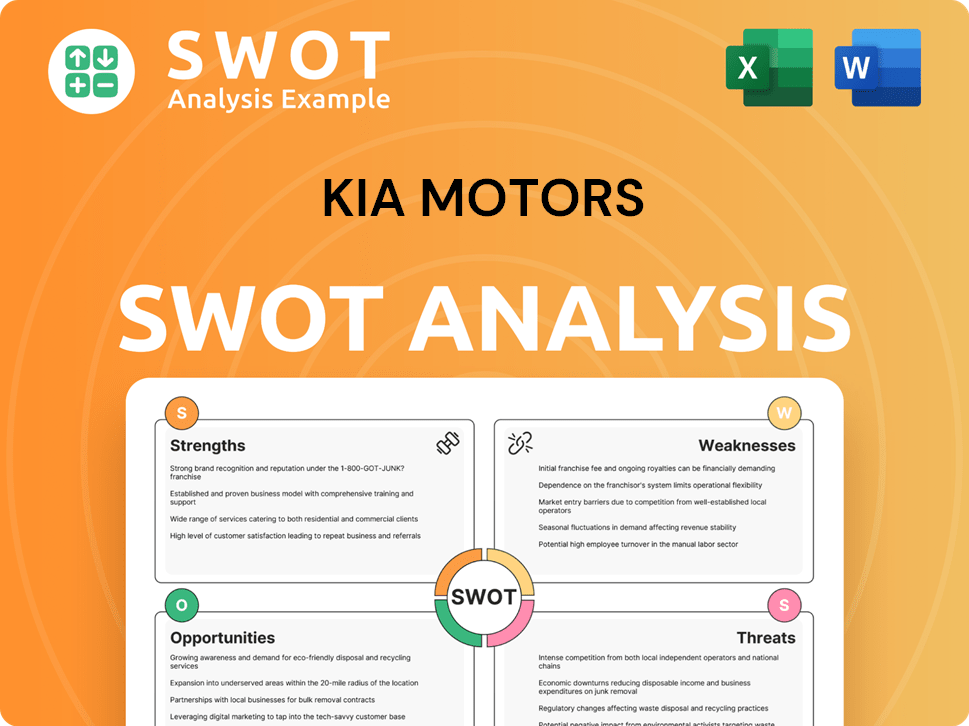
What Marketing Tactics Does Kia Motors Use?
The marketing tactics employed by the company are multifaceted, encompassing both digital and traditional strategies to boost brand awareness, generate leads, and drive sales. This approach includes a strong emphasis on digital platforms and data-driven marketing, as well as innovative methods like Augmented Reality (AR) and Virtual Reality (VR) experiences.
The company's strategy also includes a focus on customer segmentation and localized marketing efforts, tailoring campaigns to regional markets based on cultural preferences and local interests. Furthermore, the company utilizes special financing options and customer loyalty programs to attract and retain customers.
This comprehensive approach has helped the company to achieve significant market share growth and maintain a strong competitive advantage in the automotive industry. For a deeper dive into the company's ownership structure and financial performance, consider exploring the resources available for Owners & Shareholders of Kia Motors.
The company heavily utilizes digital marketing, leveraging content marketing and social media platforms like Instagram, TikTok, and YouTube. This is a key component of the company's marketing strategy, particularly for reaching younger, digitally-savvy audiences.
Social media engagement increased by 15% year-over-year in 2022, showcasing the effectiveness of its digital efforts. Influencer collaborations, particularly with micro-influencers, enhance authenticity and relevance.
Digital ad spend in the U.S. alone reached $142 million in 2021, demonstrating a strong commitment to online customer acquisition. Data-driven marketing employs demographic and behavioral data for targeted ads.
The company has embraced Augmented Reality (AR) and Virtual Reality (VR) experiences at auto shows. These technologies allow virtual test drives and feature exploration, especially for models like the EV6.
The marketing mix also incorporates traditional media, including TV, radio, print, and events. This ensures a broad reach across different demographics and media consumption habits.
Localized marketing efforts tailor campaigns to regional markets based on cultural preferences. For example, emphasizing electric and hybrid vehicles in eco-conscious European markets, where EV sales grew by 50% in 2022.
The company's marketing strategy includes special financing options, low APR deals, and cashback offers to attract new buyers. Customer loyalty rebates encourage existing customers to upgrade, fostering long-term relationships.
- Special financing options and low APR deals.
- Cashback offers to attract new buyers.
- Customer loyalty rebates to encourage upgrades.
- Localized marketing campaigns tailored to regional preferences.
Kia Motors PESTLE Analysis
- Covers All 6 PESTLE Categories
- No Research Needed – Save Hours of Work
- Built by Experts, Trusted by Consultants
- Instant Download, Ready to Use
- 100% Editable, Fully Customizable
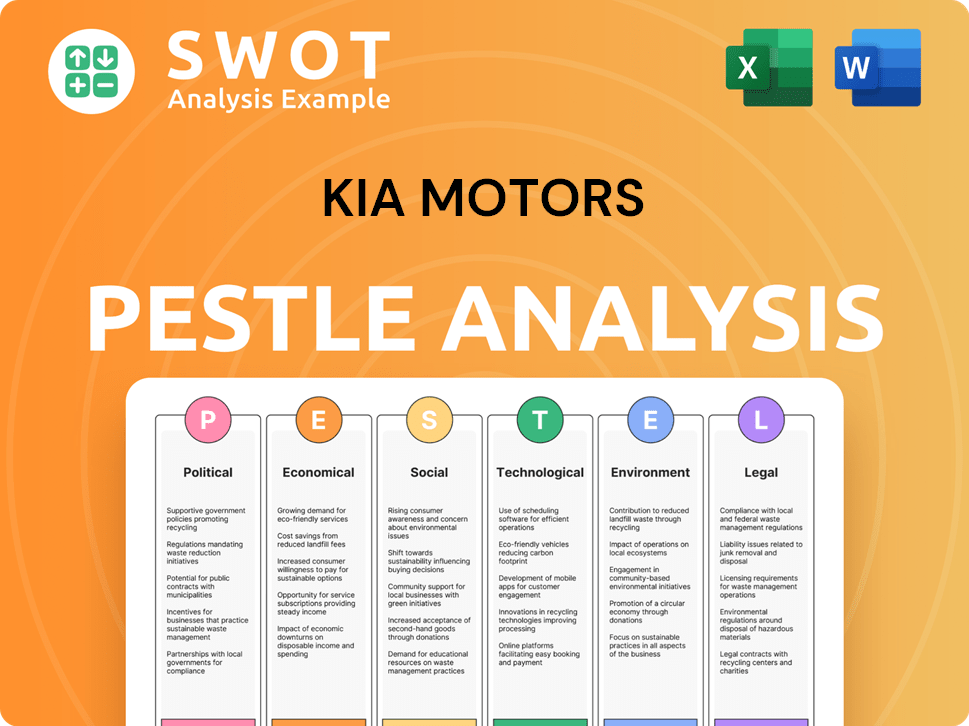
How Is Kia Motors Positioned in the Market?
The brand positioning of Kia has undergone a significant transformation, evolving from a focus on affordability to an emphasis on quality, reliability, and technological innovation. This strategic shift aims to attract a broader customer base and reshape perceptions of Kia as a dependable and stylish brand. Key to this repositioning is a commitment to offering value for money, providing quality vehicles at competitive prices with features that rival more expensive brands. This approach directly addresses the Brief History of Kia Motors, highlighting its evolution and strategic direction.
Safety remains a central pillar of Kia's brand image, reinforced by its industry-leading warranty, which was the first non-luxury automotive company to offer a 10-year, 100,000-mile warranty in the U.S. Design innovation, influenced by former Audi designer Peter Schreyer, has repositioned Kia with a more sophisticated and sporty aesthetic. The brand's core message, visual identity, and tone of voice consistently reflect this forward-looking and inspiring image. This evolution is crucial for understanding the Kia Motors marketing strategy.
Kia's strategic direction includes a strong emphasis on sustainability and technology, aligning with global trends toward eco-friendly solutions. The company's commitment to electrifying its lineup, with plans for 11 battery electric vehicles (BEVs) by the end of 2025 and a target of 6.6% global EV market share by the same year, reinforces its positioning as a leader in sustainable mobility. This is a key component of the Kia Motors sales strategy.
Kia differentiates itself by offering quality vehicles at competitive prices, providing a strong value proposition. This approach allows Kia to compete effectively in a crowded market. The focus on value is a core element of the Kia Motors competitive advantage.
The brand's design language, influenced by Peter Schreyer, has transformed Kia's image, making it more sophisticated and appealing. This design-led approach has been crucial in repositioning the brand. This is a key aspect of Kia Motors brand positioning.
Kia integrates advanced technology and features in its vehicles, enhancing the driving experience. This focus on technology helps Kia stay relevant in a rapidly evolving market. This is a key element of the Kia Motors strategy.
Kia is investing heavily in electric vehicles (EVs) to align with global trends toward eco-friendly solutions. The company aims to have 11 BEVs by the end of 2025. This commitment is a key part of Kia Motors marketing strategy for electric vehicles.
Kia's brand positioning strategy focuses on several key elements to create a distinct and appealing brand image. This approach helps the company target specific customer segments and achieve its sales goals.
- Quality and Reliability: Emphasizing the durability and dependability of its vehicles, backed by a strong warranty.
- Value for Money: Offering competitive pricing and a high level of features to attract budget-conscious consumers.
- Design and Style: Leveraging a modern and sophisticated design language to enhance brand appeal.
- Technological Advancement: Integrating advanced technology and features to improve the driving experience.
- Sustainability: Investing in electric vehicles (EVs) to meet the growing demand for eco-friendly options.
Kia Motors Business Model Canvas
- Complete 9-Block Business Model Canvas
- Effortlessly Communicate Your Business Strategy
- Investor-Ready BMC Format
- 100% Editable and Customizable
- Clear and Structured Layout
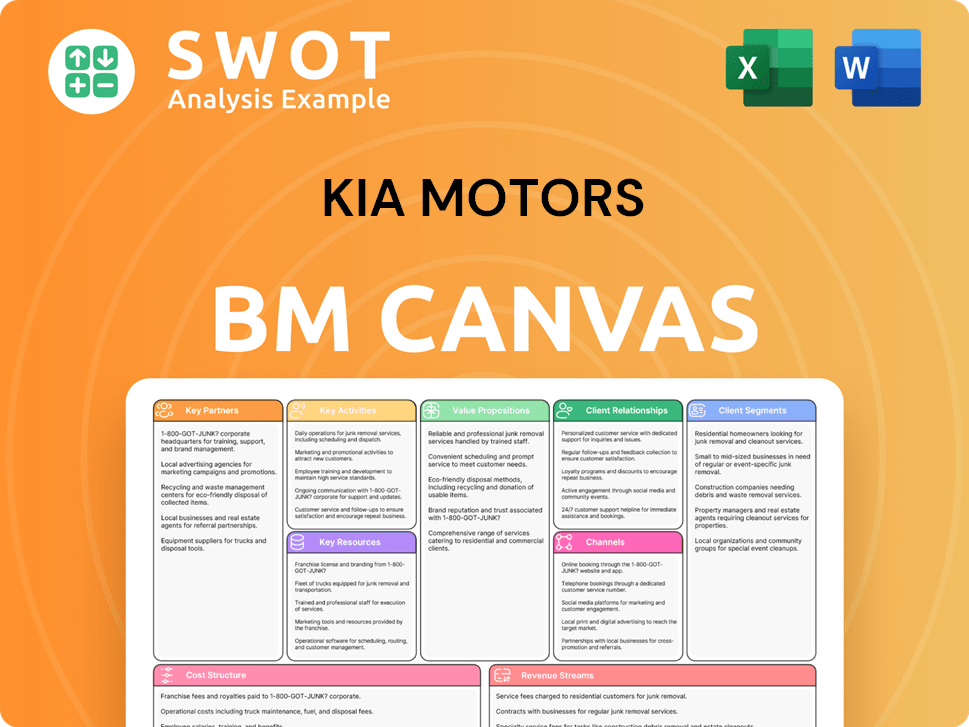
What Are Kia Motors’s Most Notable Campaigns?
The sales and marketing strategy of the company includes several key campaigns designed to boost brand awareness, drive sales, and position itself in the competitive automotive market. These campaigns are often multifaceted, incorporating digital marketing, product launches, and strategic partnerships. The company focuses on innovation, sustainability, and customer experience to resonate with modern consumers.
One of the primary goals of the company's marketing efforts is to enhance its brand image and attract a broader customer base. This is achieved through targeted advertising, strategic partnerships, and a strong emphasis on digital platforms. The company's marketing strategies are regularly updated to reflect market trends and consumer preferences.
The company's approach also involves leveraging technology to create engaging customer experiences. This includes the use of augmented reality (AR) and virtual reality (VR) in marketing campaigns, as well as digital advertising to reach a wider audience. The company's marketing efforts are designed to support its overall business objectives and drive long-term growth.
Launched in 2021, this campaign marked a significant shift in the company's brand identity, aligning with its new logo and slogan. The campaign aimed to highlight the company's focus on innovation and sustainable mobility solutions. The company's digital ad spend in the U.S. to support online channels reached $142 million in 2021.
The launch of the EV6 in 2022 was supported by a campaign emphasizing its futuristic features, ultra-fast charging capabilities, and eco-friendly design. By 2022, the EV6 had sold over 21,000 units in the U.S., significantly boosting the company's presence in the EV market. This campaign is a key example of the company's Revenue Streams & Business Model of Kia Motors.
The company's long-standing partnership with the Australian Open since 2002 has been instrumental in raising brand visibility globally. This is part of the company's global marketing strategy. These partnerships help improve brand awareness and connect with different customer segments.
- Sponsorships are often tailored to local markets, ensuring relevance and resonance with regional audiences.
- These campaigns help to build a strong brand image and increase customer loyalty.
- The company uses these opportunities to showcase its commitment to innovation and sustainability.
- Loyalty programs and exclusive offers are also used to encourage customer retention.
Kia Motors Porter's Five Forces Analysis
- Covers All 5 Competitive Forces in Detail
- Structured for Consultants, Students, and Founders
- 100% Editable in Microsoft Word & Excel
- Instant Digital Download – Use Immediately
- Compatible with Mac & PC – Fully Unlocked
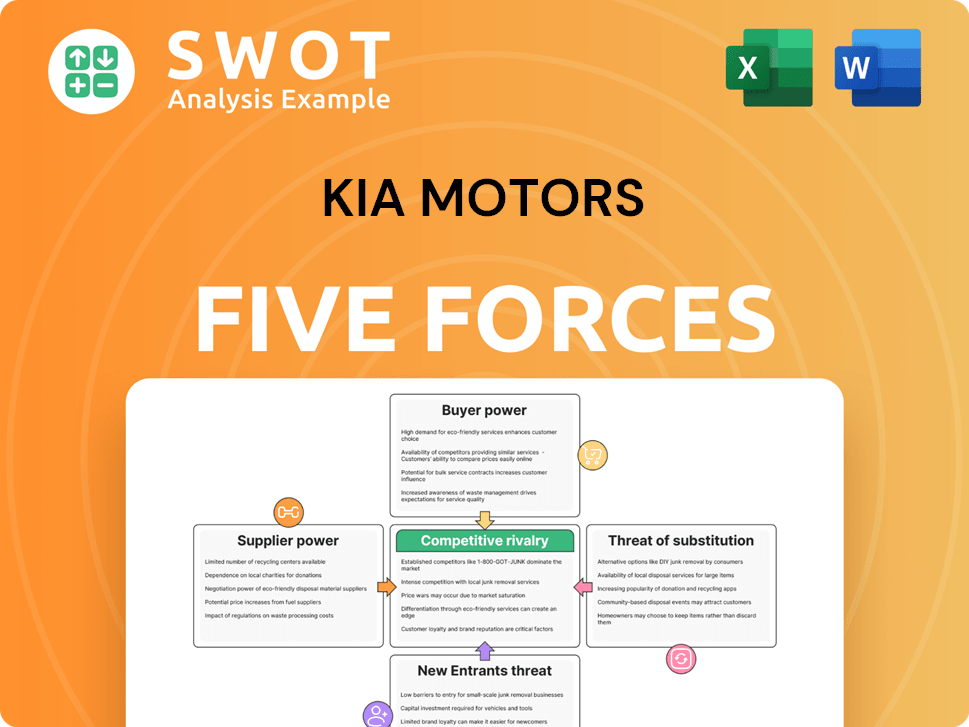
Related Blogs
- What are Mission Vision & Core Values of Kia Motors Company?
- What is Competitive Landscape of Kia Motors Company?
- What is Growth Strategy and Future Prospects of Kia Motors Company?
- How Does Kia Motors Company Work?
- What is Brief History of Kia Motors Company?
- Who Owns Kia Motors Company?
- What is Customer Demographics and Target Market of Kia Motors Company?
Disclaimer
All information, articles, and product details provided on this website are for general informational and educational purposes only. We do not claim any ownership over, nor do we intend to infringe upon, any trademarks, copyrights, logos, brand names, or other intellectual property mentioned or depicted on this site. Such intellectual property remains the property of its respective owners, and any references here are made solely for identification or informational purposes, without implying any affiliation, endorsement, or partnership.
We make no representations or warranties, express or implied, regarding the accuracy, completeness, or suitability of any content or products presented. Nothing on this website should be construed as legal, tax, investment, financial, medical, or other professional advice. In addition, no part of this site—including articles or product references—constitutes a solicitation, recommendation, endorsement, advertisement, or offer to buy or sell any securities, franchises, or other financial instruments, particularly in jurisdictions where such activity would be unlawful.
All content is of a general nature and may not address the specific circumstances of any individual or entity. It is not a substitute for professional advice or services. Any actions you take based on the information provided here are strictly at your own risk. You accept full responsibility for any decisions or outcomes arising from your use of this website and agree to release us from any liability in connection with your use of, or reliance upon, the content or products found herein.